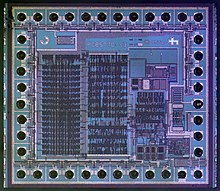Integrated circuit
Lediha electronics
An integrated circuit or monolithic integrated circuit (also referred to as an IC, a chip, or a microchip) is a set of electronic circuits on one small flat piece (or “chip”) of semiconductor material, usually silicon. Large numbers of miniaturized transistors and other electronic components are integrated together on the chip. This results in circuits that are orders of magnitude smaller, faster, and less expensive than those constructed of discrete components, allowing a large transistor count.
The IC’s mass production capability, reliability, and building-block approach to integrated circuit design has ensured the rapid adoption of standardized ICs in place of designs using discrete transistors. ICs are now used in virtually all electronic equipment and have revolutionized the world of electronics. Computers, mobile phones and other home appliances are now inextricable parts of the structure of modern societies, made possible by the small size and low cost of ICs such as modern computer processors and microcontrollers.
Integrated circuit [IC]
Very-large-scale integration was made practical by technological advancements in semiconductor device fabrication. Since their origins in the 1960s, the size, speed, and capacity of chips have progressed enormously, driven by technical advances that fit more and more transistors on chips of the same size – a modern chip may have many billions of transistors in an area the size of a human fingernail. These advances, roughly following Moore’s law, make the computer chips of today possess millions of times the capacity and thousands of times the speed of the computer chips of the early 1970s.
ICs have three main advantages over discrete circuits: size, cost and performance. The size and cost is low because the chips, with all their components, are printed as a unit by photolithography rather than being constructed one transistor at a time. Furthermore, packaged ICs use much less material than discrete circuits. Performance is high because the IC’s components switch quickly and consume comparatively little power because of their small size and proximity. The main disadvantage of ICs is the high initial cost of designing them and the enormous capital cost of factory construction. This high initial cost means ICs are only commercially viable when high production volumes are anticipated.
First integrated circuits

Robert Noyce invented the first monolithic integrated circuit in 1959. The chip was made from silicon.
A precursor idea to the IC was to create small ceramic substrates (so-called micromodules),each containing a single miniaturized component. Components could then be integrated and wired into a bidimensional or tridimensional compact grid. This idea, which seemed very promising in 1957, was proposed to the US Army by Jack Kilby and led to the short-lived Micromodule Program (similar to 1951’s Project Tinkertoy). However, as the project was gaining momentum, Kilby came up with a new, revolutionary design: the IC.
Newly employed by Texas Instrumnts, Kilby recorded his initial ideas concerning the integrated circuit in July 1958, successfully demonstrating the first working example of an integrated circuit on 12 September 1958. In his patent application of 6 February 1959, Kilby described his new device as “a body of semiconductor material … wherein all the components of the electronic circuit are completely integrated”.The first customer for the new invention was the US Air Force.[15] Kilby won the 2000 Nobel Prize in physics for his part in the invention of the integrated circuit.
Integrated circuit [IC]
However, Kilby’s invention was not a true monolithic integrated circuit chip since it had external gold-wire connections, which would have made it difficult to mass-produce. Half a year after Kilby, Robert Noyce at Fairchild Semiconductor invented the first true monolithic IC chip. More practical than Kilby’s implementation, Noyce’s chip was made of silicon, whereas Kilby’s was made of germanium, and Noyce’s was fabricated using the planar process, developed in early 1959 by his colleague Jean Hoerni and included the critical on-chip aluminum interconnecting lines. Modern IC chips are based on Noyce’s monolithic IC, rather than Kilby’s.
NASA’s Apollo Program was the largest single consumer of integrated circuits between 1961 and 1965.



